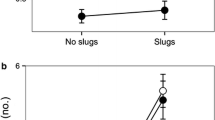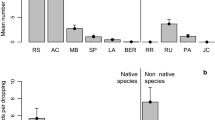Abstract
The journey of wind-dispersed seeds does not necessarily end when they land. Secondary dispersal and/or predation can positively or negatively affect the spread of invasive plants. Here we studied post-dispersal seed removal of nodding and plumeless thistle (Carduus nutans and C. acanthoides) in part of their invaded range in Pennsylvania, USA. The relative impact of small mammals and insects was determined using exclusion treatments in the field. In cages that allowed insect access, 88 % of the seeds were removed after 1 day, and 99.9 % were removed after the 6-day trial. When insects were excluded, the removal rate was significantly lower (18 % after 1 day, 40 % after 6 days). The seed removal rates provide an upper limit to the seed predation rate, with the understanding that it is also possible for seed removal to be an important secondary dispersal mechanism. We discuss a combined empirical-theoretical approach to evaluate the impact of these alternative seed fates on the spread and management of these thistles.


Similar content being viewed by others
References
Abbott I, van Heurck P (1985) Comparison of insects and vertebrates as removers of seed and fruit in a Western Australian forest. Aust J Ecol 10:165–168. doi:10.1111/j.1442-9993.1985.tb00877.x
Alba-Lynn C, Henk S (2010) Potential for ants and vertebrate predators to shape seed-dispersal dynamics of the invasive thistles Cirsium arvense and Carduus nutans in their introduced range (North America). Plant Ecol 210:291–301. doi:10.1007/s11258-010-9757-2
Allen MR, Shea K (2006) Spatial segregation of congeneric invaders in central Pennsylvania, USA. Biol Invasions 8:509–521. doi:10.1007/s10530-005-6407-z
Bates D, Maechler M, Bolker B (2013) lme4: Linear mixed-effects models using S4 classes. R package version 0.999999-2. http://CRAN.R-project.org/package=lme4
Christian CE (2001) Consequences of a biological invasion reveal the importance of mutualism for plant communities. Nature 413:635–639. doi:10.1038/35098093
Desrochers AM, Bain JF, Warwick SI (1988) A biosystematic study of the Carduus nutans complex in Canada. Can J Bot 66:1621–1631. doi:10.1139/b88-221
Gallegos SC, Hensen I, Schleuning M (2014) Secondary dispersal by ants promotes forest regeneration after deforestation. J Ecol 102:659–666. doi:10.1111/1365-2745.12226
Giladi I (2006) Choosing benefits or partners: a review of the evidence for the evolution of myrmecochory. Oikos 3:481–492. doi:10.1111/j.0030-1299.2006.14258.x
Gómez C, Espadaler X (1998) Seed dispersal curve of a Mediterranean myrmecochore: influence of ant size and the distance to nests. Ecol Res 13:347–354
Hammond DS (1995) Post-dispersal seed and seedling mortality of tropical dry forest trees after shifting agriculture, Chiapas, Mexico. J Trop Ecol 11:295–313
Harrison SK, Regnier EE, Schmoll JT (2003) Postdispersal predation of giant ragweed (Ambrosia trifida) seed in no-tillage corn. Weed Sci 51:955–964
Heggenstaller AH, Menalled FD, Liebman M, Westerman PR (2006) Seasonal patterns in post-dispersal seed predation of Abutilon theophrasti and Setaria faberi in three cropping systems. J Appl Ecol 43:999–1010
Howe HF (1986) Seed dispersal by fruit eating birds and mammals. In: Murray DR (ed) Seed dispersal. Academic Press, New York, pp 123–189
Hughes L, Westoby M (1992) Fate of seeds adapted for dispersal by ants in Australian sclerophyll vegetation. Ecology 73:1285–1299
Hulme PE (1997) Post-dispersal seed predation and the establishment of vertebrate dispersed plants in Mediterranean scrublands. Oecologia 111:91–98
Hulme PE (1998) Post-dispersal seed predation: consequences for plant demography and evolution. Perspect Plant Ecol Evol Syst 1:32–46
Jansen PA, Bongers F, Hemerik L (2004) Seed mass and mast seeding enhance dispersal by a neotropical scatter-hoarding rodent. Ecol Monogr 74:569–589
Jansen PA, Hirsch BT, Emsens W-J, Zamora-Gutierrez V, Wikelski M, Kays R (2012) Thieving rodents as substitute dispersers of megafaunal seeds. Proc Nat Acad Sci USA 109:12610–12615. doi:10.5441/001/1.9t0m888q
Jongejans E, Shea K, Skarpaas O, Kelly D, Sheppard AW, Woodburn TL (2008) Dispersal and demography contributions to population spread of Carduus nutans in its native and invaded ranges. J Ecol 96:687–697. doi:10.1111/j.1365-2745.2008.01367.x
Jongejans E, Allen MR, Leib AE, Marchetto KM, Pedatella NM, Peterson-Smith J, Rauschert ESJ, Ruggiero DC, Russo LA, Ruth LE, Sezen Z, Skarpaas O, Teller BJ, Warg LA, Yang S, Zhang R, Shea K (2011) Spatial dynamics of invasive Carduus thistles. In: Chan F, Marinova D, Anderssen RS (eds) MODSIM2011, 19th international congress on modelling and simulation. Modelling and simulation society of Australia and New Zealand, pp 2514–2520
Kelly D, McCallum K (1990) Demography, seed biology and biological control of Carduus nutans in New Zealand. In: Palmer JP (ed) The biology and control of invasive plants. British Ecological Society, Cardiff, pp 72–79
Kollmann J, Bassin S (2001) Effects of management on seed predation in wildflower strips in northern Switzerland. Agric Ecosyst Environ 83:285–296
Kollmann J, Coomes DA, White SM (1998) Consistencies in post-dispersal seed predation of temperate fleshy-fruited species among seasons, years and sites. Funct Ecol 12:683–690
Marchetto KM, Jongejans E, Jennis ML, Haner EM, Sullivan CT, Kelly D, Shea K (2010) Shipment and storage effects on the terminal velocity of seeds. Ecol Res 25:83–92. doi:10.1007/s11284-009-0634-1
Marchetto KM, Shea K, Kelly D, Groenteman R, Sezen Z, Jongejans E (2014) Unrecognized impact of a biocontrol agent on the spread rate of an invasive thistle. Ecol Appl 24:1178–1187. doi:10.1890/13-1309.1
Mauchline AL, Watson SJ, Brown VK, Froud-Williams RJ (2005) Post-dispersal seed predation of non-target weeds in arable crops. Weed Res 45:157–164. doi:10.1111/j.1365-3180.2004.00443.x
Moupela C, Doucet J-L, Daïnou K, Tagg N, Bourland N, Vermeulen C (2014) Dispersal and predation of diaspores of Coula edulis Baill. in an evergreen forest of Gabon. Afr J Ecol 52:88–96. doi:10.1111/aje.12089
Nathan R (2007) Total dispersal kernels and the evaluation of diversity and similarity in complex dispersal systems. In: Dennis AJ, Schupp EW, Green RA, Westcott DA (eds) Seed dispersal: theory and its application in a changing world. CABI, pp 252–276
Neubert MG, Caswell H (2000) Demography and dispersal: calculation and sensitivity analysis of invasion speed for structured populations. Ecology 81:1613–1628. doi:101890/0012-9658(2000)081[1613:DADCAS]20CO;2
Ohnishi YK, Katayama N, Suzuki N (2013) Differential dispersal of Chamaesyce maculata seeds by two ant species in Japan. Plant Ecol 214:907–915. doi:10.1007/s11258-013-0217-7
O’Rourke ME, Heggenstaller AH, Liebman M, Rice ME (2006) Post-dispersal weed seed predation by invertebrates in conventional and low-external-input crop rotation systems. Agric Ecosyst Environ 116:280–288
Pemberton RW, Irving DW (1990) Elaiosomes on weed seeds and the potential for myrmecochory in naturalized plants. Weed Sci 38:615–619
Peterson-Smith J, Shea K (2010) Seedling emergence and early survival of Carduus spp. in three habitats with press and pulse disturbances. J Torrey Bot Soc 137:287–296. doi:10.3159/09-RA-070R1.1
Pierce SM, Cowling RM (1991) Dynamics of soil-stored seed banks of six shrubs in fire-prone dune fynbos. J Ecol 79:731–747. doi:10.2307/2260664
Prior KM, Saxena K, Frederickson ME (2014) Seed handling behaviours of native and invasive seed-dispersing ants differentially influence seedling emergence in an introduced plant. Ecol Entomol 39:66–74. doi:10.1111/een.12068
Pufal G, Klein A-M (2013) Post-dispersal seed predation of three grassland species in a plant diversity experiment. J Plant Ecol 6:468–479. doi:10.1093/jpe/rtt011
Reader RJ (1993) Control of seedling emergence by ground cover and seed predation in relation to seed size for some old-field species. J Ecol 81:169–175
Redbo-Torstensson P, Telenius A (1995) Primary and secondary seed dispersal by wind and water in Spergularia salina. Ecography 18:230–237. doi:10.1111/j.1600-0587.1995.tb00126.x
Retana J, Picó FX, Rodrigo A (2004) Dual role of harvesting ants as seed predators and dispersers of a non-myrmechorous Mediterranean perennial herb. Oikos 105:377–385. doi:10.1111/j.0030-1299.2004.12854.x
Rey PJ, Garrido JL, Alcántara JM, Ramirez JM, Aguilera A, García L, Manzaneda AJ, Fernández R (2002) Spatial variation in ant and rodent post-dispersal predation of vertebrate-dispersed seeds. Funct Ecol 16:773–781. doi:10.1046/j.1365-2435.2002.00680.x
Schurr FM, Bond WJ, Midgley GF, Higgins SI (2005) A mechanistic model for secondary seed dispersal by wind and its experimental validation. J Ecol 93:1017–1028. doi:10.1111/j.1365-2745.2005.01018.x
Sheppard AW, Cullen JM, Aeschlimann JP (1994) Predispersal seed predation on Carduus nutans (Asteraceae) in Southern Europe. Acta Oecol 15:529–541
Skarpaas O, Shea K (2007) Dispersal patterns, dispersal mechanisms and invasion wave speeds for invasive thistles. Am Nat 170:421–430. doi:10.1086/519854
Skarpaas O, Silverman EJ, Jongejans E, Shea K (2010) Are the best dispersers the best colonizers? Seed mass, dispersal and establishment in Carduus thistles. Evol Ecol 25:155–169. doi:10.1007/s10682-010-9391-4
Terborgh J, Losos E, Riley MP, Riley MB (1993) Predation by vertebrates and invertebrates on the seeds of five canopy tree species of an Amazonian forest. Vegetatio 107(108):375–386. doi:10.1007/978-94-011-1749-4_26
Türke M, Heinze E, Andreas K, Svendsen SM, Gossner MM, Weisser WW (2010) Seed consumption and dispersal of ant-dispersed plants by slugs. Oecologia 163:681–693. doi:10.1007/s00442-010-1612-6
Vander Wall SB, Forget P-M, Lambert JE, Hulme PE (2005a) Seed fate pathways: filling the gap between parent and offspring. In: Forget P-M, Lambert JE, Hulme PE, Vander Wall SB (eds) Seed fate: predation, dispersal and seedling establishment. CAB International, Wallingford, pp 1–8
Vander Wall SB, Kuhn KM, Beck MJ (2005b) Seed removal, seed predation, and secondary dispersal. Ecology 86:801–806
Weiss FE (1908) The dispersal of fruits and seeds by ants. New Phytol 7:23–28
Wenny DG (2001) Advantages of seed dispersal: a re-evaluation of directed dispersal. Evol Ecol Res 3:51–74
Westerman PR, Wes JS, Kropff MJ, van der Werf W (2003) Annual losses of weed seeds due to predation in organic cereal fields. J Appl Ecol 40:824–836
Whelan CJ, Willson MF, Tuma CA, Souza-Pinto I (1991) Spatial and temporal patterns of postdispersal seed predation. Can J Bot 69:428–436
Yang S, Jongejans E, Yang S, Bishop JG (2011) The effect of consumers and mutualists of Vaccinium membranaceum at Mount St. Helens: dependence on successional context. PLoS One 6:e26094
Acknowledgments
Emily Rauschert and Zeynep Sezen provided thoughtful contributions to the experimental design and procedures. Candace Davison lent her expertise in gamma irradiation and conducted the seed irradiations. Sarah Perkins was helpful in identifying small mammals at the field site. Jessie Blake Lough, Steven Selego and Evin Brown assisted in the field. Sarah Assman and 3 anonymous reviewers provided useful comments on the manuscript. This research was partly funded by the National Science Foundation (Grant DEB-0315860). E.J.S. received funding from the PSU Schreyer Honors College.
Author information
Authors and Affiliations
Corresponding author
Electronic supplementary material
Below is the link to the electronic supplementary material.
Supplementary material 4 (AVI 26021 kb)
Supplementary material 5 (AVI 17790 kb)
Supplementary material 6 (AVI 16744 kb)
About this article
Cite this article
Jongejans, E., Silverman, E.J., Skarpaas, O. et al. Post-dispersal seed removal of Carduus nutans and C. acanthoides by insects and small mammals. Ecol Res 30, 173–180 (2015). https://doi.org/10.1007/s11284-014-1224-4
Received:
Accepted:
Published:
Issue Date:
DOI: https://doi.org/10.1007/s11284-014-1224-4




